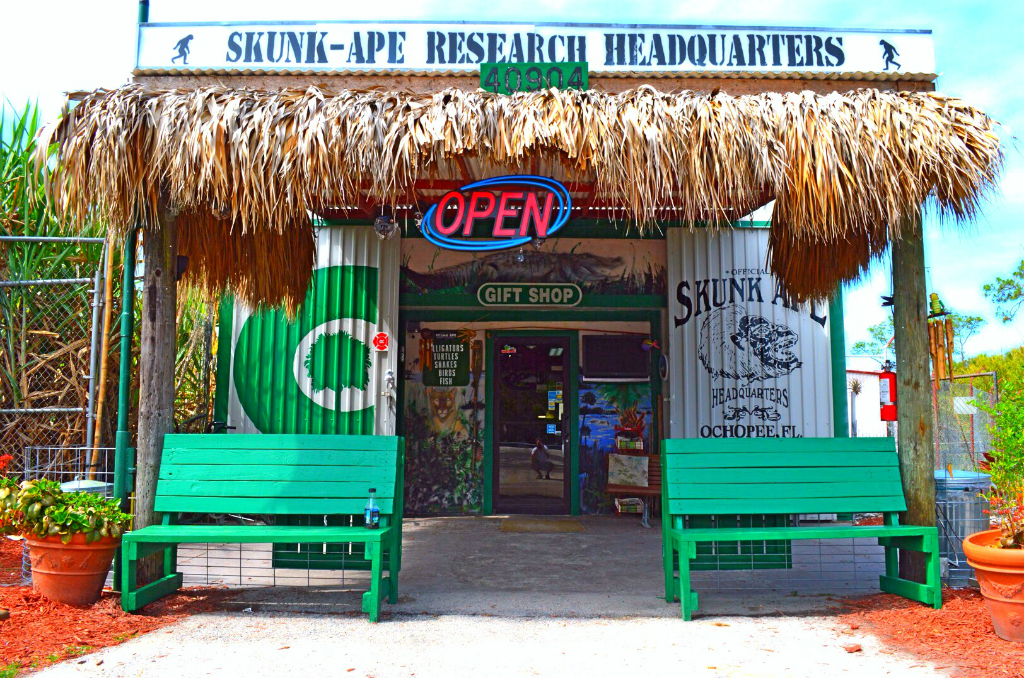Swamp Cabbage Man. Swamp Ape. Stink Ape. Swampsquatch. Florida Bigfoot.
No matter what nickname you use, Florida’s Skunk Ape continues to elude researchers. That’s where Dave Shealy and his facility come in.
Atlas Obscura calls Shealy “the Jane Goodall of the Florida Everglades,” and with good reason. Shealy has spent the last 30 years in search of the legendary creature.
He snapped his first picture of the animal in 1997 and captured video of it in 2000, but his first ever encounter was at the age of 10.
“It was walking across the swamp, and my brother spotted it first. But I couldn’t see it over the grass – I wasn’t tall enough. My brother picked me up, and I saw it, about 100 yards away. We were just kids, but we’d heard about it, and knew for sure what we were looking at. It looked like a man, but completely covered with hair,” All That’s Interesting quoted Shealy.
Shealy’s pursuit of the Swampsquatch led him to open the Skunk Ape Research Headquarters. The gift-shop-meets-museum research facility is in Ochopee, past the smallest post office in the United States and before the Big Cypress National Preserve.
“A lot of folks coming here, the first thing they ask is, ‘What is the Skunk Ape?’” Jack Shealy told CBS4 News. “The Skunk Ape is the southernmost relative of Bigfoot, like a Yeti or a Sasquatch. All of the stories over the years add up to sightings of some sort of large mammal in the Glades.”
When Shealy and his son Jack aren’t giving tours, the duo are conducting studies and investigating sightings. The elder Shealy is convinced there are seven to nine Skunk Apes currently prowling the Everglades.
Based on pictures, video and eyewitness testimonies, the Skunk Ape has long red or black hair, stands between 6 to 8 feet tall and weighs between 250 to 450 pounds. But it’s one particular quality that really sets Florida’s mysterious monster apart from its worldwide counterparts: its smell. Roadside America explains it as “swamp gas clinging to its abundant hair” that can be “compared to a trash dumpster on a hot day.”
“They smell really, really, really bad,” Crystal Diff told the North Port Sun. “In all of the reports, the first thing people notice is a really bad odor that smells like a skunk, or some say a really wet dog… rotting meat.”
According to the Bigfoot Field Researchers Organization, there have been over 320 confirmed Skunk Ape sightings across the Sunshine State. Mick Minnis, a volunteer researcher for the BFRO, believes the overall number of sightings is much, much higher.
“Only about 25 percent of people who have a Bigfoot sighting ever come forward,” he told the Northwest Florida Daily News. “People have been ostracized, ridiculed and had their jobs and relationships threatened. It’s a tough thing to do.”
Shealy, who claims to have seen a Swamp Ape on four different occasions, outlined his creature-luring tactics in his “Everglades Skunk Ape Research Field Guide.”
“Unmistakably the best baits available are dry beans. Black eye peas, pinto and kidney beans all work well, however large lima beans are the recommended bait and should be considered your first choice,” he explains in the guide, which you can buy at his headquarters.
On the off chance you don’t want to venture deep into the Everglades in the hopes of luring one, Shealy’s property is located on the Trail Lakes Campground where you can rent a chickee hut, park your RV or pitch a tent for an overnight stay.
Also on Shealy’s grounds are some animal exhibits that include alligators, turtles and Goldie, a 21-foot, 350-pound reticulated python.
Skunk Ape Research Headquarters is open seven days a week from 9 to 5 with admission being $15 for adults and $8 for children. It’s located at 40904 Tamiami Trail East, Ochopee, FL.
Melissa’s career in writing started more than 20 years ago. Today, she lives in South Florida with her husband and two boys.

